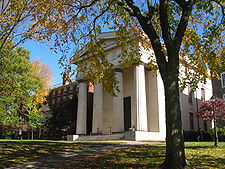
The College of Brown University
Encyclopedia

Brown University
Brown University is a private, Ivy League university located in Providence, Rhode Island, United States. Founded in 1764 prior to American independence from the British Empire as the College in the English Colony of Rhode Island and Providence Plantations early in the reign of King George III ,...
in Providence, Rhode Island
Providence, Rhode Island
Providence is the capital and most populous city of Rhode Island and was one of the first cities established in the United States. Located in Providence County, it is the third largest city in the New England region...
.
History
On March 3, 1764, James ManningJames Manning
James Manning was an American Baptist minister, educator and legislator from Providence, Rhode Island best known for being the first president of Brown University and one of its most involved founders. He was born in Elizabethtown, New Jersey. At the age of 18 he attended the Hopewell Academy...
and Ezra Stiles
Ezra Stiles
Ezra Stiles was an American academic and educator, a Congregationalist minister, theologian and author. He was president of Yale College .-Early life:...
filed a charter to create the College of Rhode Island. Their mission, as stated in the charter, was to prepare students "for discharging the Offices of Life" by providing instruction in the Vernacular Learned Languages, and in the liberal Arts and Sciences." Manning became the College's first president in 1765, and five years later the school moved to its present location on College Hill
College Hill, Providence, Rhode Island
College Hill is a neighborhood in Providence, Rhode Island, and one of six neighborhoods comprising the East Side of Providence and part of College Hill Historic District. It is roughly bounded by North Main Street to the west, Power Street to the south, Governor Street and Arlington Avenue to...
on the East Side of Providence.
In 1850, Brown President Francis Wayland
Francis Wayland
Francis Wayland , American Baptist educator and economist, was born in New York City, New York. He was president of Brown University and pastor of the First Baptist Church in America in Providence, Rhode Island. In Washington, D.C., Wayland Seminary was established in 1867, primarily to educate...
wrote, "The various courses should be so arranged that, insofar as practicable, every student might study what he chose, all that he chose, and nothing but what he chose." However, the College did not make any major institutional changes for over a century. In 1969, the New Curriculum was implemented, eliminating distribution requirements and allowing students to take any course Satisfactory/No Credit. In addition, the University eliminated pluses, minuses, and D grades in the letter grading system.
Degrees granted
The College offers two different baccalaureate degrees: bachelor of artsBachelor of Arts
A Bachelor of Arts , from the Latin artium baccalaureus, is a bachelor's degree awarded for an undergraduate course or program in either the liberal arts, the sciences, or both...
(A.B.) and bachelor of science
Bachelor of Science
A Bachelor of Science is an undergraduate academic degree awarded for completed courses that generally last three to five years .-Australia:In Australia, the BSc is a 3 year degree, offered from 1st year on...
(Sc.B.)
Concentrations
|
|
|
A.B./Sc.B.
Students have the ability to graduate in five years with both an A.B. and Sc.B. degree, provided that requirements for each degree are met. This is distinct from a double concentration, when students only receive one degree.PLME
The Program in Liberal Medical Education is a single eight-year program that allows students to complete both an undergraduate degree (A.B. or Sc.B.) from The College and subsequently an M.D. degree from Alpert Medical School. Admission to PLME is highly competitive; each year approximately 50 students matriculate out of an applicant pool of 1,970.Brown-RISD
While students at The College have long been able to cross register for classes at nearby Rhode Island School of DesignRhode Island School of Design
Rhode Island School of Design is a fine arts and design college located in Providence, Rhode Island. It was founded in 1877. Located at the base of College Hill, the RISD campus is contiguous with the Brown University campus. The two institutions share social, academic, and community resources and...
, it is now possible to complete an A.B. from Brown and a B.F.A. degree from RISD concurrently over a five year period. Students must be admitted to both institutions separately in order to matriculate.

